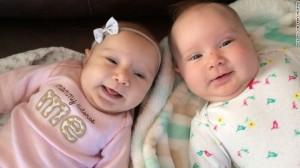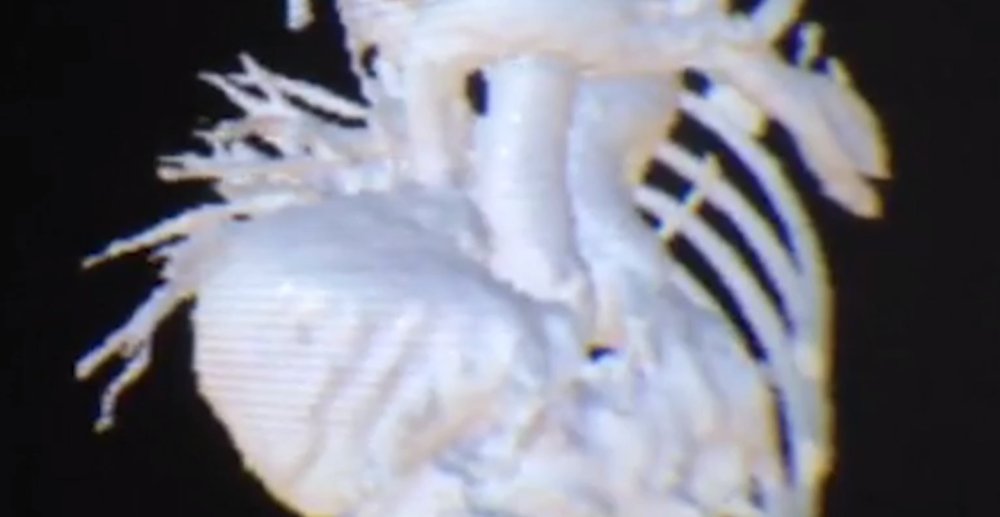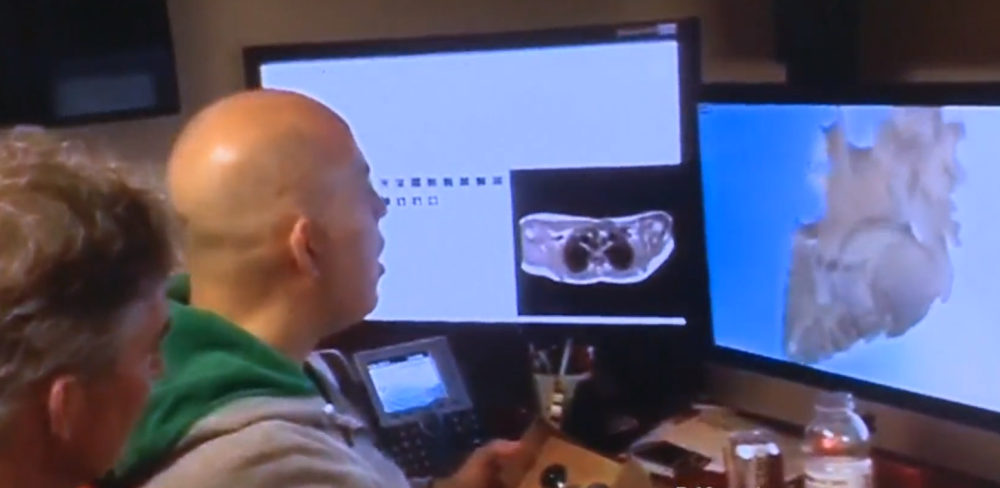Teegan was a medical case so rare that none of the doctors who worked with her had ever seen it. She was born with only a single lung and a strange heart defect that left her with only the right side of her heart. Her original doctors in Minnesota had told her parents, Cassidy and Chad Lexcen, that there simply wasn’t anything that they could do and sent their daughter home with a nurse and medication to make her as comfortable as they could until she passed away. Which has to be just about the most horrific thing a parent can be told to do, especially with a healthy twin sister as a constant reminder of what their baby could be growing into if she had a healthy heart.
After two months with baby Teegan still holding on, the Lexcens refused to just give up on her. With Teegan’s sister Riley rapidly growing, the couple searched other specialists until they finally came across Dr. Redmond Burke, who was named “The 20 Most Innovative Pediatric Surgeons Alive Today” and the chief of cardiovascular surgery at Miami’s Nicklaus Children’s Hospital. After reaching out to Dr. Burke his office returned their email immediately and asked for all of the images and information that they had and a promise to see if they could help.
In a nondescript room at Nicklaus Children’s Hospital more than thirty cardiac doctors and nurses gather three times a week to decide which children will become their patients. After Dr. Burke and his staff looked over Teegan’s heart they wanted to get a better picture of the problem and see if they could conceive of a solution. Like her doctors in Minnesota the consensus seemed to be that there was very little that could be done. Teegan’s tiny little heart was not like normal hearts, and not in the same position.
In order to access her heart, and to make any surgical corrections, doctors would need to perform a horrifically invasive series of incisions that would be devastating to such a small and unhealthy child. Typically the heart can be accessed with a single cut running from the top of the breast bone down to the bottom. But Teegan’s was further over to the left on her chest cavity, and in order to reach it Dr. Burke would seemingly need to make what is called clamshell incision which is not only the cut on the breastbone but another going from the center of her chest to the right side of her body. With only half of a functional heart for her whole life, Teegan had spent three months “slowly dying,” so Dr. Burke was doubtful that she could survive such an invasive surgery.
In order to get a better look at Teegan’s heart defect, Dr. Burke asked to see a 3D printed replica of her heart, but a cardiologist on his team who specializes in imaging had some bad news for him. Unfortunately Dr. Juan Carlos Muniz had to tell Burke that the hospital’s 3D printer was down and they would be unable to print the heart, but Dr. Muniz had another idea that might potentially give Dr. Burke the information that he needs without a 3D printer. After discussing the possibility of using virtual reality technology to get better views of a patient’s heart with other surgeons, Dr. Muniz had purchased a Google Cardboard headset and installed the Sketchfab app on his smartphone. He hadn’t had much time to really explore the technology, but Teegan’s case seemed to be an ideal time to give it a shot.
Using a cardboard pair of VR goggles Dr. Burke was able to view not only Teegan’s heart but the entire internal structure of her little body. The VR headset actually gave him a better idea of what would need to be done in order to save her life. Dr. Burke was even able to plan a way into her chest that didn’t involve the dangerous clamshell incision because the VR view of Teegan’s body allowed him to see where her ribs and the rest of her internal structures were, allowing him to visualize a path around them.
Dr. Burke had baby Teegan on the operating table on December 10th and because of her size and health had very little time to save her life. He was able to essentially invent an entirely new surgical procedure just for Teegan’s case using the Google Cardboard VR headset. He was able to rebuild her entire heart because he knew exactly where everything was, thanks to the VR view. It had actually given him a better idea of what to expect than a 3D printed heart replica ever would have. The surgery went much quicker than had he tried to do it based entirely on 2D imaging, and because he had become so familiar with Teegan’s chest cavity thanks to Google Cardboard, the procedure went off without any problems. Discuss this remarkable story in the 3D Printing / Google Cardboard Saves Life forum on 3DPB.com.
Here is a local news report on Teegan’s Google Cardboard-powered surgery:
Only four weeks after her life-saving surgery baby Teegan was able to be removed from her ventilator and started to finally breathe on her own. She’s doing so well that her doctors expect that within the next two weeks she will be able to go home and make a full recovery. The repair done to her heart will allow it to function without any problems or difficulties and allow her to live a normal life, just like her sister. All thanks to Dr. Burke, his team and a $20 cardboard headset with a cell phone stuffed inside of it. The next time someone tells you that virtual reality is just a video game peripheral and won’t be much more than a toy, tell them about baby Teegan, a life that wouldn’t be here had it not been for that toy.
Subscribe to Our Email Newsletter
Stay up-to-date on all the latest news from the 3D printing industry and receive information and offers from third party vendors.
You May Also Like
3D Printing Financials: Fathom Struggles in Financial Quicksand During Critical Transition
Facing a year of key transitions and financial pressures, Fathom (Nasdaq: FTHM) has filed its annual report for 2023 with the U.S. Securities and Exchange Commission (SEC). The document outlines...
Latest Earnings Overview for Australian 3D Printing Firms Titomic and AML3D
Australian 3D printing manufacturing firms Titomic (ASX: TTT) and AML3D (ASX: AL3) reported their financial results for the period from July to December 2023, marking the first half of their...
3D Printing Webinar and Event Roundup: April 7, 2024
Webinars and events in the 3D printing industry are picking back up this week! Sea-Air-Space is coming to Maryland, and SAE International is sponsoring a 3D Systems webinar about 3D...
3D Printing Financials: Unpacking Farsoon and BLT’s 2023 Performance
In the Chinese 3D printing industry, two companies, Farsoon (SHA: 688433) and Bright Laser Technologies, or BLT (SHA: 688333), have recently unveiled their full-year earnings for 2023. Farsoon reported increases...




































